The stories, poems, and “scraps” Jane Austen wrote in her teenage years are now well known as her juvenilia—crazy, irreverent, transgressive miniatures of a wildly creative mind playing and experimenting with literature. During the same years, Austen was studying music and forming a collection of songs and keyboard pieces that would stay with her throughout her life. The details and dates are uncertain, but sometime after her return from school in 1786, a piano was bought for her, and she seems to have been still having lessons ten years later.1
Not all the music she studied is known. Some music was sold with her piano when the Reverend and Mrs. Austen and their two daughters left Steventon (Vick 295), but other music books belonging to her survive among the family music collections, including three manuscript books with piano music and songs copied out in her own hand. These music manuscripts are those of a practicing musician, written for herself to perform, and it therefore seems likely that she had both lessons and regular access to an instrument from at least the early 1790s. Although at least one of her teachers, George William Chard (1765?–1849), was assistant organist at Winchester Cathedral, most of her music is secular, and much of it is vocal music.2
Elsewhere I have written about possible links between “Colin and Lucy,” a 1783 ballad of which Jane Austen had a print copy, and the plot of Sense and Sensibility. Here I look more specifically at the manuscript music from her mid- to late teens in tandem with her teenage writings. The songs that Austen played and sang during her teenage years exhibit (inter alia) irony, absurd humor, shallow sentimentality, and political protest. Joyfully mimicking some, while mercilessly mocking others, in her juvenilia Austen engages in dialog with these songs.
The Austen family music books
The Austen family contained a small circle of musical women, including Jane Austen’s niece Fanny Knight and her sisters-in-law: Edward’s wife, Elizabeth (née Bridges), and Henry’s wives, Eliza (née Hancock), who died in 1813, and Eleanor (née Jackson), whom he married after Jane’s death. A collection of their music books, both printed and handwritten, including Jane’s own manuscript books, has come down to us via their descendants. This music collection is now available to view on Internet Archive, thanks to Professor Jeanice Brooks and the University of Southampton Library.3 Brooks and her colleagues have examined the music books in great detail and summarized their findings on the Austen Family Music Books site at Internet Archive.4
Kathryn Sutherland and Freya Johnston observe that Austen’s juvenilia, or teenage writings, were not “intended only for the author’s private use. Rather, they were written and prepared for sociable reading and for circulation and performance among family and friends” (xi). This intent may also have applied to at least some of the music manuscript books. There is debate about the handwriting of some manuscripts, and it is often difficult to know for certain who owned a particular piece of printed music. Some of the books are signed “C. E. Austen,” probably by Cassandra, who was not a musician. One could speculate that she wrote her name in the books after Jane’s death as a mark of ownership when she was lending them among friends or family. Having worked with this music since 2007, I have with a fair amount of confidence identified 140–150 pieces of music as written in Jane Austen’s handwriting, apparently across the course of her life. The music dates from the 1780s onwards, with the latest being a little dance titled “The Waterloo,” which can be confidently dated to about 1815.5
What music was feeding the creative imagination of this young artist? There is no way we can know for sure what music Austen particularly liked to play and sing in her teenage years. Decades later, her niece Caroline recorded memories of a few songs that she sang to her as a child.6 But in this early period, we can only guess that those songs Jane took the trouble to copy by hand into her manuscript books might have been favorites—although it would also be revealing if she spent money on buying music, expensive at that time.
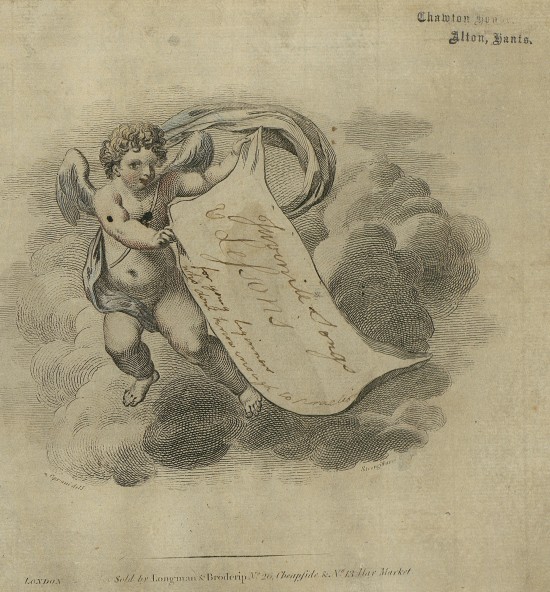
Juvenile Songs and Lessons
(Click here to see a larger version.)
There are three music books from this period with manuscripts in Austen’s hand. Two are commercially available blank music manuscript books, pre-ruled. These two were bought as blank manuscript books and filled in sequentially. One has a decorative title page on which is the slightly misleading but delightfully written “Juvenile Songs and Lessons.”7 A note added below, in smaller writing, reads “for young beginners who don’t know enough to practise.” There is no vocal music in this album, so no “songs,” and although there are some relatively simple pieces of music, there are also some fairly substantial and demanding pieces, such as reductions of operatic overtures that are well beyond the skill of a “young beginner.” The pieces that appear at the beginning of the book were copied from music published in the early 1790s; since Austen had probably been learning the piano since her school days, she was certainly not a beginner at this stage.8 We could speculate that some Lady Catherine de Bourgh-like person had made a remark about “young beginners not knowing enough to practise” and that Austen felt mischievously compelled to record the insult on the title page of her manuscript book. Apart from providing a perfect title for my paper, this book is not of much interest to me in this essay because it is in the (vocal) songs that we can most clearly see links between the teenage writings and the music that Austen was playing when she wrote them.
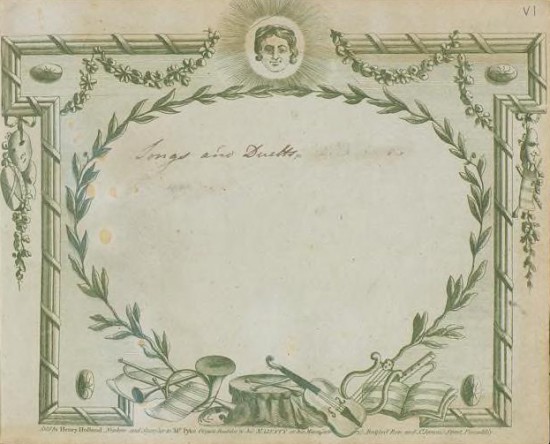
Songs and Duetts
(Click here to see a larger version.)
The other commercially printed, blank music manuscript book, dating from the late 1780s and just labelled “Songs and Duetts,” may have been started earlier but seems to have overlapped with the “Juvenile Songs and Lessons” volume, as it includes pieces of music dating from the mid-1790s.9 “Songs and Duetts” is more aptly named. All but one of its thirty-seven items are vocal works, most of them solo songs with keyboard accompaniment, but some are duets and some have other instrumental parts as well.
The third book is a scrapbook-style volume, where items are not necessarily still in the order in which they were inserted.10 It contains a mixture of printed music and manuscripts that range in date throughout Austen’s lifetime. About fifteen of the manuscripts are copies of music that dates from the period when Austen was writing the juvenilia.
Songs in the juvenilia
In these teenage writings, Austen occasionally includes a song lyric. In the introduction to the Juvenilia Press edition of Frederic and Elfrida, Sylvia Hunt writes that the juvenilia are “not only the apprentice work of a budding writer but also a commentary through parody on the ridiculous aspects of the sentimental novel” (x). Austen’s music collection shows that she was also well aware of the ridiculous aspects of the sentimental song. Austen writes three song lyrics for Frederic & Elfrida (1787–1790).11 One, in the best folksong tradition, is overheard by the characters when they are out walking:
That Damon was in love with me
I once thought & beleiv’d
But now that he is not I see,
I fear I was deceiv’d. (Minor Works 5)
This song might be a direct reference to “How gentle was my Damon’s air” from Thomas Arne’s 1738 masque setting of Milton’s Comus, a song included in a later manuscript book.12 There is a comic contrast between the perfunctory common sense of Austen’s version and the plaintive agonizing of the nymph in Comus, who wanders disconsolately around the countryside while “all nature does my loss deplore.”
The Epitaph on the death of Charlotte, who extricates herself from a tricky romantic situation by throwing “herself into a deep stream which ran thro’ her Aunt’s pleasure Grounds in Portland Place”—itself a ludicrous concept—and floats conveniently but impossibly to her home village (9), though not explicitly a song, has many possible musical models, including “My Phillida” by Miss Mellish, which is almost silly enough in parts to have been written by the young Austen.
Her corps shall be attended by maids in fair array,
Till the obsequies are ended and she is wrapt in clay.
Ding dong, my Phillida is dead,
I’ll stick a branch of willow at my fair Philli’s head.13
The narrator of Frederic & Elfrida first gives Charlotte’s Epitaph:
Here lies our friend who having promis-ed
That unto two she would be marri-ed
Threw her sweet Body & her lovely face
Into the Stream that runs thro’ Portland Place. (9)
The song is followed by prose: “These sweet lines, as pathetic as beautiful were never read by anyone who passed that way, without a shower of tears, which if they should fail of exciting in you, Reader, your mind must be unworthy to peruse them” (9). Having thus cavalierly disposed of one of the main characters, possibly for the sole purpose of composing “sweet,” “pathetic,” and “beautiful” lines on her, and having directed this unexpected beam of authorial bossiness towards the unwary reader, the narrator skips off to relate the next scene, in which Rebecca’s mother is persuaded at the point of a dagger to allow her to marry her fiancé forthwith. Naturally, they celebrate with a song, about Corydon buying a ribbon for Bess, with which she “made herself look very fess” (10). Corydon, like Damon, is a stock romantic name, the bridegroom in James Hook’s delightful 1784 pastoral song “The Wedding Day,” included in Austen’s “Songs and Duetts” manuscript book.14
In The First Act of a Comedy (1793), a mere two pages sets up a farcical plot, complete with two songs sung by “Chloe & a chorus of ploughboys” (MW 173-74)—which could have been written, one hundred years later, by W. S. Gilbert.15 The eighteenth-century English stage was teeming with knockabout musical comedies, and Austen must have seen some of them. Her music collection includes many songs from the theatre: often musically quite simple, with straightforward harmonies and tunes borrowed from Italian opera or Scottish folk music.
In her own “Ode to Pity” from 1793, Austen delights in the humor of high-flown language—e.g., “the Paths of honour and the Myrtle Grove” (74)—juxtaposed with the ridiculous: “Gently brawling down the turnpike road, / Sweetly noisy falls the Silent Stream” (75). This little comic ode could have had any number of models, but who else but the teenage Austen could write:
The hut, the Cot, the Grot, & Chapel queer,
And eke the Abbey too a mouldering heap,
Conceal’d by aged pines her head doth rear
And quite invisible doth take a peep. (75)
The comedy of contradictions, abrupt changes in register, and absurd word play is clearly something Austen relished in her own work and no doubt enjoyed in that of other writers and musicians.
Charles Dibdin and “The Joys of the Country”: Comedy and contradiction
Sutherland and Johnston discuss the influence of Alexander Pope and Samuel Johnson on Austen’s capacity “to engineer comic flops, to stage a series of triumphant verbal and syntactic let-downs” (xxxii). They might have added the songwriter Charles Dibdin (1745–1814) to this duo. Four of Dibdin’s songs appear in Austen’s teenage repertoire, and others crop up in later volumes of her music: she seems to have gravitated to him more than any other composer.
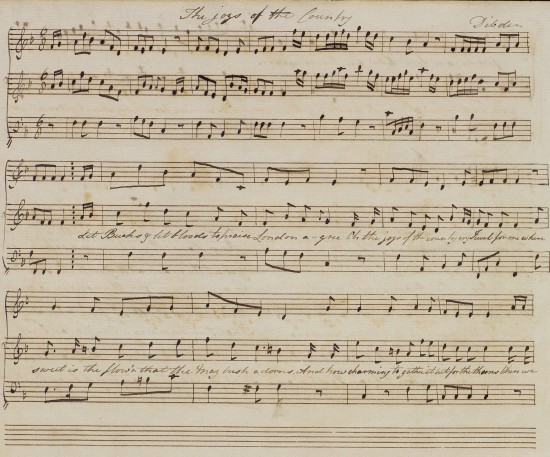
“The Joys of the Country” by Charles Dibdin. Gillian Dooley with Fiona McCauley (piano) and Chris Rawlinson (violin).
Recorded live, Adelaide 2011.
(Click here to listen.)
(Click here to see a larger version.)
Dibdin often performed his own songs in a series of one-man shows in theatres around London, in a career spanning the period from the early 1760s to the Regency. He developed a large repertoire of characters: he varied the register and tone of his songs, from the comic to the “pathetic” and the grandiose (Carrasco 167), and “his amazing ability to mimic provincial accents” and people of different social classes meant he could carry the audience with him through an evening’s program containing nearly three dozen songs (Russell 101). One of the songs from The Wags, 1790 “entertainment,” is “The Joys of the Country,” and it appears in Austen’s manuscript book.
Let bucks and let bloods to praise London agree,
The joys of the country my jewel for me!
Where sweet is the flower that the maybush adorns,
And how charming to gather it, but for the thorns.
Where we walk o’er the mountains with health our cheeks glowing,
As warm as a toast honey when it ent snowing,
Where nature to smile when she joyful inclines,
And the sun charms us all the year round, when it shines.
Oh the mountains and vallies and bushes,
The pigs and the screech owls and thrushes!
Let bucks and let bloods to praise London agree,
The joys of the country my jewel for me!
In this first verse, we have a comic litany of contradictions: we enjoy the maybush but for the thorns; it’s warm as long as it isn’t snowing; the sun charms—when it shines. The refrain celebrates “mountains and vallies and bushes” in one breath, only to come to “pigs and screech owls and thrushes” in the next line, in a comic juxtaposition of the sublime and the ridiculous.
Austen often employs this tactic in her teenage writings. In Love and Freindship (1790), for example, the protagonist Laura writes:
“The place was suited to meditation.—. A Grove of full-grown Elms sheltered us from the East—. A Bed of full-grown Nettles from the West—. Before us ran the murmuring brook & behind us ran the turn-pike road.” (97)
That passage in turn echoes the contradictory “gentle brawling” of the turnpike road and the impossibility of a “Sweetly noisy” “Silent Stream” in Austen’s “Ode to Pity.”
In the very masculine second verse of Dibdin’s “The Joys of the Country,” the men are hunting and fishing; the rain that begins while they are walking with female relatives offers the delighted singer and his friends a vision of diaphanous clothing clinging to the figures of each “fair she.”
There twelve hours on a stretch we in angling delight,
As patient as Job tho’ we ne’er get a bite.
There we pop at the wild ducks and frighten the crows,
While so lovely the icicles hang from our cloathes.
There wid Aunts and wid Cousins & Grandmothers talking
We are caught in the rain as we’re all out a‐walking
While the muslins and gauzes cling round each fair she
That they look all like Venuses sprung from the sea.
Oh the mountains and vallies and bushes,
The pigs and the screech owls and thrushes!
Let bucks and let bloods to praise London agree,
The joys of the country my jewel for me!
The hyperbolic world of this verse is akin to much of the juvenilia: one might think of Sir William Mountague, his “Park well stocked with Deer,” his refusal to get married on the first of September because he “was a Shot & could not support the idea of losing such a Day,” and his propensity to fall “violently in love” with every lovely young woman he sees (41-42).
In the third verse the jokes continue, with heavy irony that might remind us of Mary Crawford’s amused horror at country ways, decades later, in Mansfield Park.
Then how sweet in the dogdays to take the fresh air
Where to save you expence the dust powders your hair.
There pleasures like snowballs encrease as they roll
And tire you to death—not forgetting the Bowl,
Where in mirth and good fellowship always delighting
We agree, that is when we’re not squabbling and fighting
Then wid toasts and pint bumpers we bodder the head
Just to see who most gracefully staggers to bed.
Oh the mountains and vallies and bushes,
The pigs and the screech owls and thrushes!
Let bucks and let bloods to praise London agree,
The joys of the country my jewel for me!16
Although the singer claims, in the refrain of each verse, to leave the admiration of London to “bucks and bloods” while he seeks “the joys of the country,” his is a very urban sensibility. He notices the dust along with the fresh air and is exhausted by “pleasures like snowballs.” Then they visit the “Bowl,” or public house, where all is harmony, except when it’s not, and they compete in drunkenness and in who can “most gracefully stagger to bed.” Dibdin’s country people are somewhat more restrained than the Johnsons in Austen’s Jack & Alice (1787–1790): “the Bottle being pretty briskly pushed about . . . , the whole party . . . were carried home, Dead Drunk” (14).
This song was published in 1790, and the other songs around it in Austen’s manuscript book are from the early 1790s. She may not have known the song at the time, when she was writing the earlier juvenilia, but Austen and Dibdin both clearly relished the same comic traditions of ludicrous juxtapositions, hyperbole, and mockery of masculine swaggering and drunkenness.
Austen obviously enjoyed Dibdin’s well-crafted and singable songs, which she must have sung herself, without any qualms about their explicitly masculine subject positions. A similar lack of regard towards established gender roles also appears in the juvenilia. In Frederic & Elfrida, for example, the two title characters are introduced as “exceedingly handsome and so much alike, that it was not every one who knew them apart” (4). Their distinguishing features are listed, but difference in sex is not one of them. And the exploits of some of her heroines are far from ladylike: The Beautifull Cassandra (c. 1788), for example, steals bonnets and ices completely without compunction and strides around the streets of London for seven hours (44–47); Eliza, in Henry & Eliza (1787–1790), escapes from prison and walks thirty miles “without stopping” (37–38). As Karen Hartnick writes,
Eliza lives out the traditional male adventure—she leaves her family, travels, faces danger, demonstrates cunning and bravery, and defeats her enemies in armed battle. . . . Only in the juvenilia would Jane Austen allow her heroine a hero’s rewards. (xiii)
Austen would have enjoyed the license to escape the confines of femininity when singing these songs, which, Molly Sandock proposes, allowed women “a sort of free space, an expanded experimental realm giving them a wider range of roles and possibilities than their domestic lives did” (115). Singing, even in private, is a way of taking on and trying out different subject positions and could only have stimulated Austen’s creative imagination.
The Mansion of Peace”: Formulaic sentimentality
In many other songs in Austen’s music manuscript books, the singer is explicitly male, but often they have little else in common with Dibdin’s comic songs. For example, “The Mansion of Peace,” by Samuel Webbe (1740–1816), is a highly sentimental love song in a strain that is satirized in many of the teenage pieces. In A Collection of Letters (1792), Henrietta’s lover Musgrove writes: “‘Adorable Henrietta how beautiful you are! I declare you are quite divine! You are more than Mortal. You are an angel. You are Venus herself’” (163). This passage shares the same strain of hyperbolic flattery as the lyrics of “The Mansion of Peace”:
Soft zephyr on thy balmy wing
Thy gentlest breezes hither bring.
Her slumbers guard, some hand divine.
Ah! Watch her with a care like mine.A rose, a rose from her bosom has strayed,
I’ll seek to replace it, replace it with art.
But no, no no, twill her slumbers invade.
I’ll wear it (fond youth) next my heart.Alas, silly rose, silly rose hadst thou known,
’Twas Daphne that gave thee thy place.
Thou never, no never, from thy station hadst flown.
Her bosom’s the Mansion of Peace.
This song was published in 1780 in Dublin but is the second-last song in Austen’s manuscript book, so it can’t have been copied until after other songs from about 1794. (Despite the masculine persona, a 1790 London edition attributed the text to “A Lady.”)
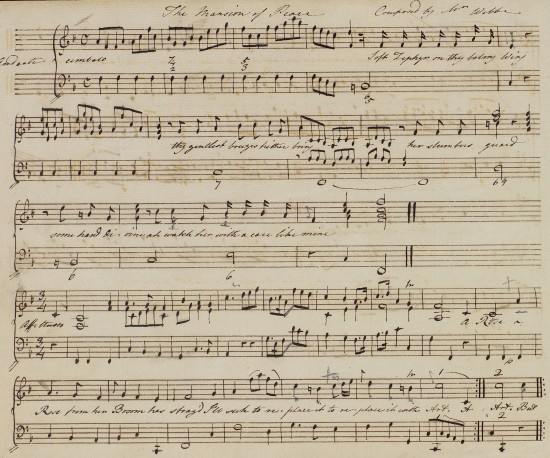
“The Mansion of Peace” by Samuel Webbe. Gillian Dooley with Alistair Knight (piano). Recorded live, Adelaide 2020.
(Click here to listen.)
(Click here to see a larger version.)
This kind of lyric was typical of the artificial and formulaic eighteenth-century poetic diction that the Romantic movement rejected and that Austen mocked so gleefully in A Collection of Letters and other teenage writings. Austen’s naïve and rather gullible character Henrietta might be just as delighted with the inane flattery of this song as she had been with Musgrove’s love letter (contained in “Letter the fifth”), which exaggerates these tropes even more. Another song is directly referenced in this letter. Henrietta’s friend Lady Scudamore reports Musgrove’s saying,
“Yes I’m in love I feel it now,
And Henrietta Halton has undone me—”
which Henrietta finds “‘a Sweet Way . . . of declaring his Passion!’” (167). These lines are adapted from a lyric by William Whitehead:
Yes, I’m in love, I feel it now,
And Celia has undone me;
And yet I’ll swear, I can’t tell how,
The pleasing plague stole on me.’Tis not her face that love creates,
For there no graces revel;
’Tis not her shape,
For there the Fates have rather been uncivil.’Tis not her air, for sure in that
There’s nothing more than common;
And all her sense is only chat,
Like any other woman.Her voice, her touch, might give th’ alarm;
’Tis both, perhaps, or neither;
In short, ’Tis that provoking charm
Of Celia all together!17
It is lucky—Austen’s joke—that Henrietta didn’t hear the whole poem, because it is not quite as flattering as she might expect.
Austen surely knew this poem, perhaps in one of its musical settings, although it is not in her collection. She quotes it again in Mansfield Park when Henry Crawford tells his sister Mary that he has fallen in love with Fanny Price: “‘How the pleasing plague had stolen on him’ he could not say” (292). It forms part of the disconcerting discussion between Mary and Henry in which they set about organizing Fanny’s future without the slightest acknowledgement that she might have other ideas. It is interesting that in her maturity Austen alludes again to this rather insulting lyric. Its tone undercuts the artificial sentimentality of songs like “The Mansion of Peace” more subtly but as surely as Austen’s juvenilia satirizes the sentimental fiction of the period.
“For Tenderness Form’d”: Injured innocence
Another staple of the sentimental repertoire of the time is what we might call the song of an innocent, and often hard-done-by, young person. In Henry and Eliza, Eliza sits under a tree, “happy in the conscious knowledge of her own Excellence” and amusing herself by “making & singing the following Lines”:
Though misfortunes my footsteps may ever attend
I hope I shall never have need of a Friend
as an innocent Heart I will ever preserve
and will never from Virtue’s dear boundaries swerve. (34)
The joke here is of course that she is far from innocent and has been turned out of her benefactors’ house because she has stolen fifty pounds. Austen very consciously subverts this genre, with which she was certainly familiar.
There are several songs in this vein in Austen’s music books. One is “For Tenderness Form’d,” which appears as print music in the scrapbook volume. The song comes from John Burgoyne’s play The Heiress (1786). The melody is adapted by Thomas Linley from an aria in Italian composer Giovanni Paisiello’s score for his opera The Barber of Seville.
For tenderness form’d in life’s early day,
A parents soft sorrows to mine led the way;
the lesson of pity was caught from her eye,
and e’er words were my own, I spoke with a sigh.The nightingale plunder’d, the mate widow’d dove,
the warbled complaint of the suffering grove,
to youth as it ripen’d gave sentiment new,
the object still changing the sympathy true.Soft embers of passion yet rest in their glow,
a warmth of more pain may this breast never know,
or if too indulgent the blessing I claim,
let the spark drop from reason that weakens the flame.18
“For Tenderness Form’d” is a well-crafted and effective expression of this species of modest self-promotion.
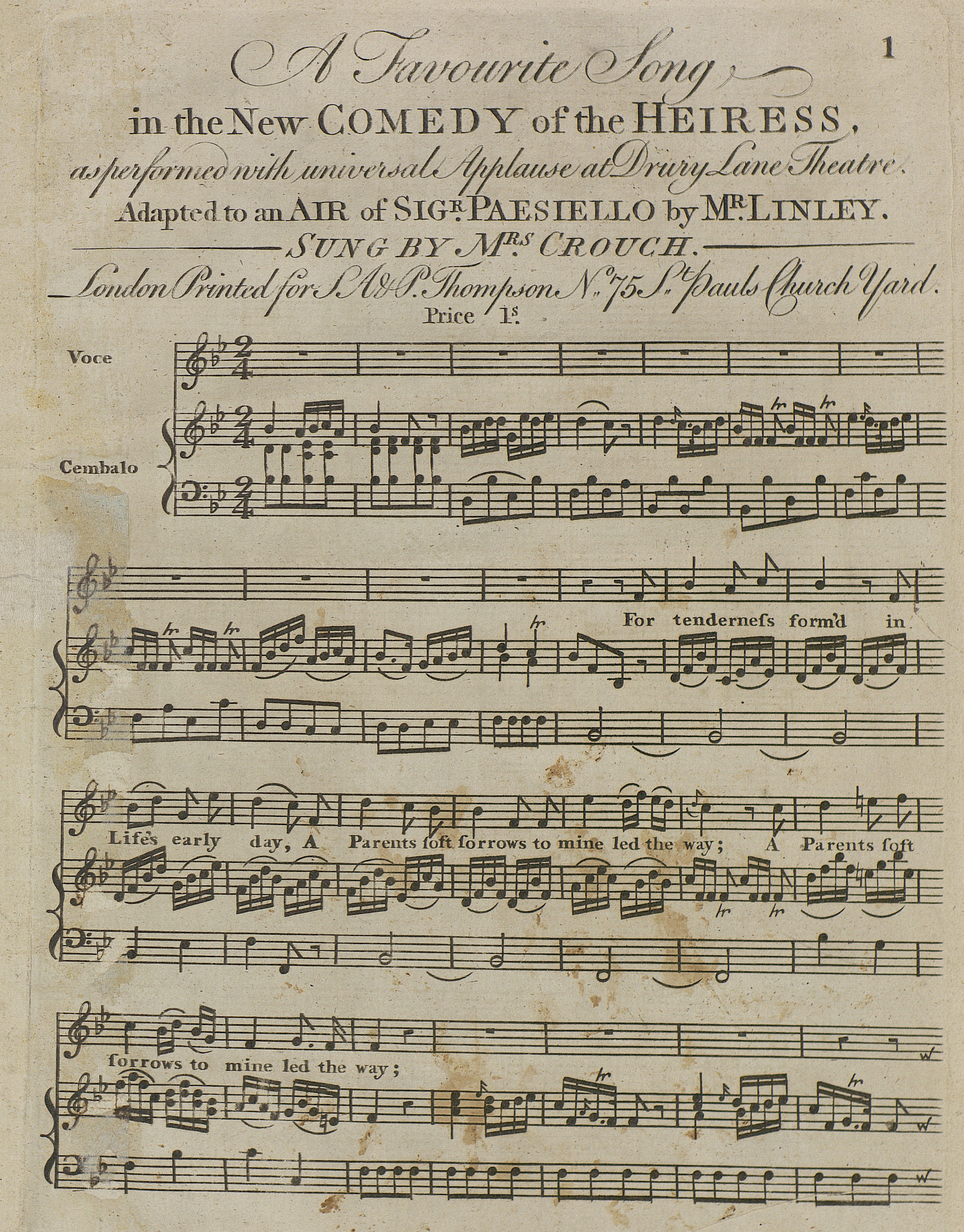
“For Tenderness Form’d”, melody by G. Paisiello arranged by Thomas Linley. Gillian Dooley with Alistair Knight (piano).
Recorded live, Adelaide 2020.
(Click here to listen.)
(Click here to see a larger version.)
Another song in this vein, “Since Then I’m Doom’d,” is more of a tear-jerker. It comes from Isaac Bickerstaff’s 1792 play The Spoil’d Child and, incidentally, also takes its melody from a version of The Barber of Seville, in this case the original 1775 French stage production of Beaumarchais’s play. The character Little Pickle sings this song at the end of the first act, on being banished from his home after cooking his aunt’s pet parrot in a pie (Bickerstaff). The lyrics begin,
Since then I’m doom’d this sad reverse to prove,
to quit each object of my infant care.
Torn from an honoured parent’s tender love,
and driven the keenest storms of fate to bear.19
This song is in Austen’s manuscript book but probably dates from 1792, slightly later than most of the juvenilia, and certainly later than Henry and Eliza, but the lyrics, with their lavish self-pity, echo Eliza’s situation more closely than “For Tenderness Form’d.” What Eliza’s song and these two theatre songs share is the slightly absurd pathos of injured innocence in a self-justifying lament.
“Queen Mary’s Lamentation”: Doomed queens
A more serious type of lament also appears in this manuscript book. There is a long tradition of lamentations “supposed to be written” by a historical figure, often a queen awaiting execution. The two lamentations in Austen’s manuscript book are a ballad titled “Captivity,” first published in 1793, and a version of “Queen Mary’s Lamentation” from 1782. “Captivity” is one of several songs about Marie Antoinette composed at the time by English musicians (Rice 163–64, 176ff).20 In his lyrics, Hampshire-based Anglican minister Joshua Jeans provides a sentimental and rather lurid imagining of Marie Antoinette’s distress before her execution in 1793. She weeps over “my babes [who] lie hushed in sleep, / In briny tears their couch I steep” and imagines “My murdered Lord . . . / The headless truck, the bosom gor’d.” Stephen Storace’s restrained setting of Jeans’s rather melodramatic (though not unrealistic) lyrics creates a sympathetic and moving portrait of the doomed French queen.
"Captivity" by Stephen Storace. Gillian Dooley with Mike Parker (harp). Recorded live, Jane Austen Festival, Bath, 2012
The theme of the imprisoned queen lamenting her fate continues. Immediately after this ballad in Austen’s music manuscript comes Tommaso Giordani’s 1782 arrangement of the traditional Scottish air “Queen Mary’s Lamentation.”21
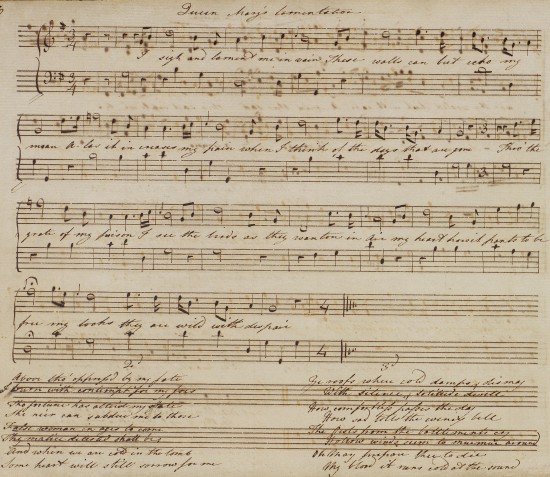
"Queen Mary’s Lamentation”, trad. Arranged Tommaso Giordani. Gillian Dooley with Mike Parker (harp). Recorded live, Jane Austen Society Conference, Abingdon, UK, 2012.
(Click here to listen.)
(Click here to see a larger version.)
I sigh and lament me in vain,
These walls can but echo my moan:
Alas it increases my pain,
When I think of the days that are gone!
Through the grate of my prison, I see
The birds as they wanton in air;
My heart how it pants to be free,
My looks they are wild with despair.Above, tho’ opprest by my fate,
I burn with contempt for my foes;
Tho’ fortune has alter’d my state,
She ne’er can subdue me to those.
False woman! In ages to come,
Thy malice detested shall be;
And, when we are cold in the tomb,
Some heart still will sorrow for me.Ye roofs! where cold damps and dismay,
With silence and solitude dwell,
how comfortless passes the day,
How sad tolls the evening bell!
The owls from the battlements cry,
Hollow winds seem to murmur around,
“O Mary, prepare thee to die:”—
My blood it runs chill at the sound.
The links between these two ballads, one about Queen Marie Antoinette and the other about Mary, Queen of Scots, both in captivity, awaiting violent death at the hands of their political enemies, are emphasized by their juxtaposition in Austen’s manuscript book.
Mary Spongberg points out that in her youthful, parodic The History of England, written in November 1791, “Austen rendered Mary Stuart’s fate central to the history of England by mentioning her in the reign of every single Tudor monarch” (70). The History of England is for the most part witty and wildly satirical, but when it came to Queen Elizabeth’s crimes against Mary, Austen’s wit falls away and is replaced by passionate intensity:
[W]hat must not her most noble mind have suffered when informed that Elizabeth had given orders for her Death! Yet she bore it with a most unshaken fortitude, firm in her Mind; Constant in her Religion; & prepared herself to meet the cruel fate to which she was doomed, with a magnanimity that could alone proceed from conscious Innocence. (MW145)
The sentiments expressed in Austen’s strongly partisan rhetoric are shared by the lyrics of “Queen Mary’s Lamentation.” The words are not actually by Mary, Queen of Scots: although some of her poetry does survive, in this case both the words and tune are anonymous. The song dramatizes Mary’s plight, using for the most part clichéd sentimental melodramatic verse. Some lines in the second verse stand out: “I burn with contempt for my foes,” and “False woman, / In ages to come, thy malice detested shall be.” The implication, of course, is that the “foes” are the English and that the “false woman” is Queen Elizabeth. Austen’s version is more explicit:
It was the peculiar Misfortune of this Woman to have bad Ministers—Since wicked as she herself was, she could not have committed such extensive mischeif, had not these vile & abandoned men connived at, & encouraged her in her crimes. (144–45)
This passage threatens to tip over into absurdity, but there is no doubting Austen’s strong partiality for the Stuart cause and her awareness of the historical context.
![]()
G. K. Chesterton wrote in his preface to an early edition of the juvenilia, that “there is not a shadow of indication anywhere that this independent intellect and laughing spirit was other than contented with a narrow domestic routine, in which she wrote a story as domestic as a diary in the intervals of pies and puddings, without so much as looking out of the window to notice the French Revolution” (xv). That edition included The History of England, however, which, although often very funny, is an explicitly Jacobite text. The evidence of Austen’s first manuscript book of songs, which contains within just a few pages the lament of Marie Antoinette and what is now the French national anthem, “The Marseillaise,” and other songs with political angles both explicit and implicit, further complicates this picture.22 Austen could not have composed the high-spirited and eloquent fragments in her teenage years without a knowledge of the theatrical world of her day. And the contents of Austen’s music collection provide further insights to the evolving picture of the historical, social, and cultural milieu in which she wrote.
ACKNOWLEDGEMENT
The high-resolution images were provided by the Jane Austen’s House. We are very grateful.
NOTES
1“From Mrs. Austen’s letter of 31 December 1786, it would seem that a pianoforte had then been only borrowed for the period of the Christmas family gathering, but thereafter one was acquired on a more permanent basis and Jane received music lessons until at least 1796” (Le Faye 58). Austen mentions practicing the piano every day for Chard’s sake in a letter to Cassandra dated 1 September 1796.
2According to Squire, “Chard wrote a little unimportant music.” Most of it is secular. We can judge for ourselves in this YouTube video, as Ros Oswald plays George Chard’s “The Suwarrow Waltz.” https://youtu.be/Sge4wEaa-J4
3The contents of these music books can be searched on the University of Southampton Library Catalogue: https://www-lib.soton.ac.uk/uhtbin/cgisirsi/?ps=CHj9Qm5XRW/HARTLEY/X/60/502/X
4The work done by Brooks et al. builds on and corrects earlier accounts of this music by Patrick Piggott (1979) and Ian Gammie and Derek McCulloch (1996). My own project to provide detailed catalogue records on the Southampton University Library Catalogue for each performable piece of music in the collections focuses on identifying and dating the works as far as is possible. The vastly increased availability of music indexes and archival collections online has allowed a level of certainty that was unimaginable even for Gammie and McCulloch in 1996 and certainly for Piggott in 1979.
5https://archive.org/details/austen1676477-2001/page/n156/mode/1up
6See Brooks for a discussion of these songs.
7https://archive.org/details/austen1671983-2001
8This manuscript book was printed by London music publishers Longman and Broderip, in business 1779–1798, and was probably produced before 1794.
9https://archive.org/details/austen1672310-2001
10https://archive.org/details/austen1676459-2001
11I am relying on Sutherland and Johnston’s suggested chronology of composition of the various items in their edition of the Teenage Writings.
12https://archive.org/details/austen1676477-2001/page/n64/mode/1up
13https://archive.org/stream/austen1672310-2001#page/n47/mode/2up
14https://archive.org/stream/austen1672310-2001#page/n57/mode/2up
15In the notes to the Juvenilia Press edition of “The First Act of a Comedy,” the significance of the “chorus of ploughboys” is discussed in some detail: “By selecting ploughboys as her chorus, JA seems to exaggerate how very ‘unmusical’ these musical comedies were in comparison with the sophistication, complexity and harmony of the traditional opera style” (Austen, Three Mini-Dramas 35 n.59).
16https://archive.org/stream/austen1672310-2001#page/n19/mode/2up
17The song has been published under several titles, including “The Tout-Ensemble,” “The Pleasing Plague,” “To Celia,” “Celia’s Charms,” and “The Je ne scay quoy,” in settings by several composers including Thomas Arne and George Frederic Handel. See information at The LiederNet Archive.
18https://archive.org/stream/austen1676459-2001#page/n176/mode/1up
19https://archive.org/stream/austen1676459-2001#page/n140/mode/1up
20I differ from Paul F. Rice in his assumption that “supposed to be sung” implies that Jeans and Storace were attempting to pass this song off as a composition of Marie Antoinette. I believe that “supposed” in this case simply means “imagined.”
21Austen’s version includes only the melody, bass part, and instrumental interludes or “symphonies” of Giordani’s setting for string quartet and voice published by Preston in 1792. See the catalogue record at Southampton University Library for more details. https://www-lib.soton.ac.uk/uhtbin/cgisirsi/x/0/0/57/5/3?searchdata1=1785392%7BCKEY%7D&searchfield1=GENERAL%5ESUBJECT%5EGENERAL%5E%5E&user_id=WEBSERVER
22See my article “Jane Austen and the Music of the French Revolution” for a discussion of the French music in Austen’s manuscript books.
